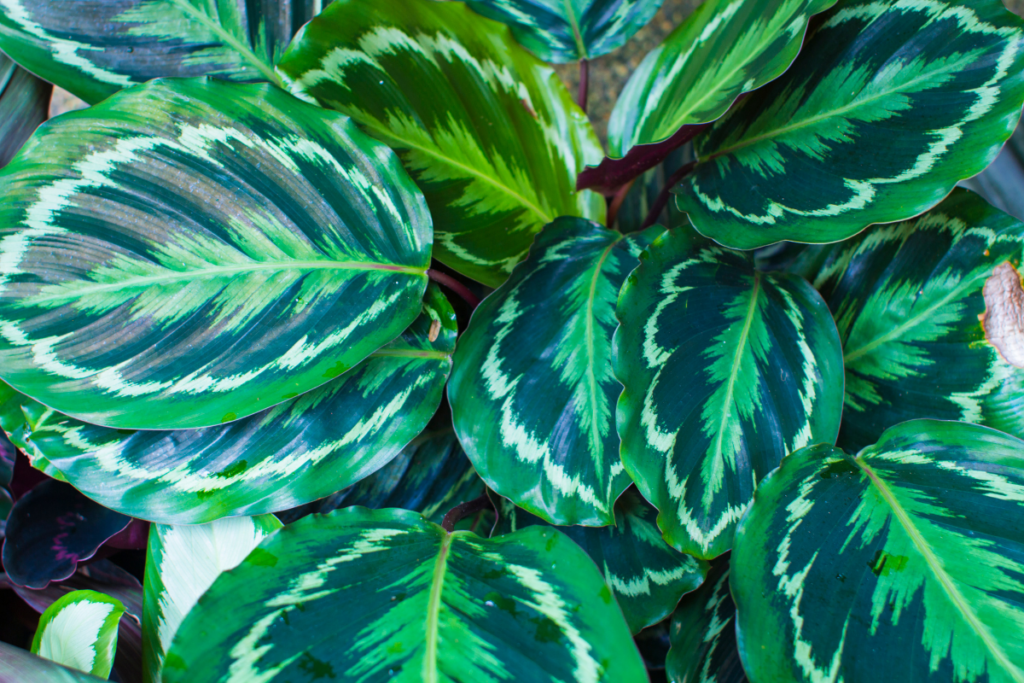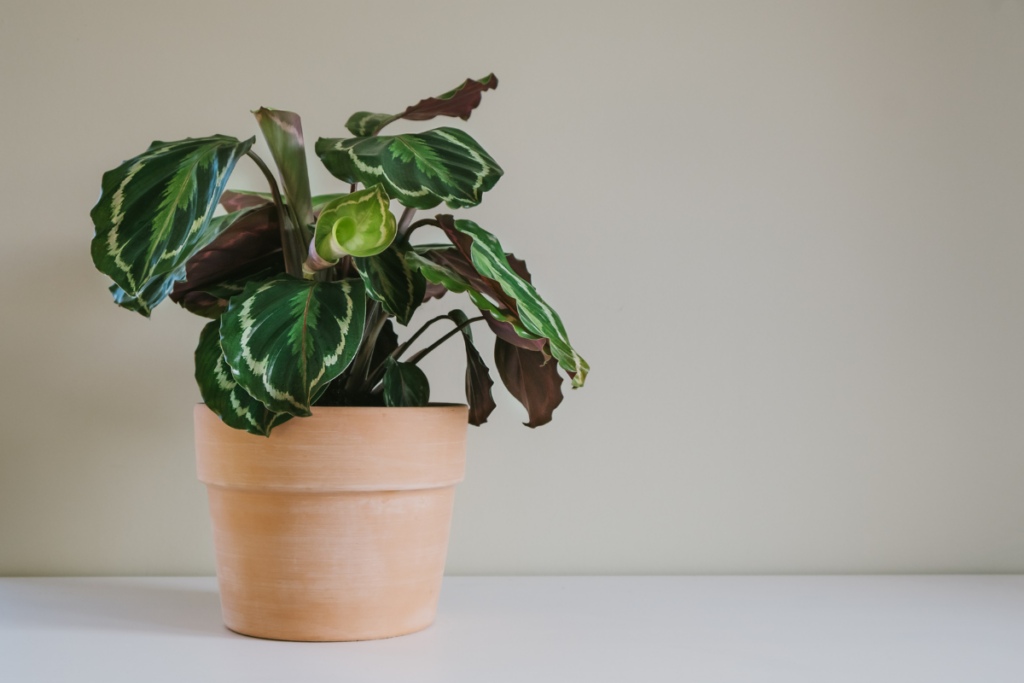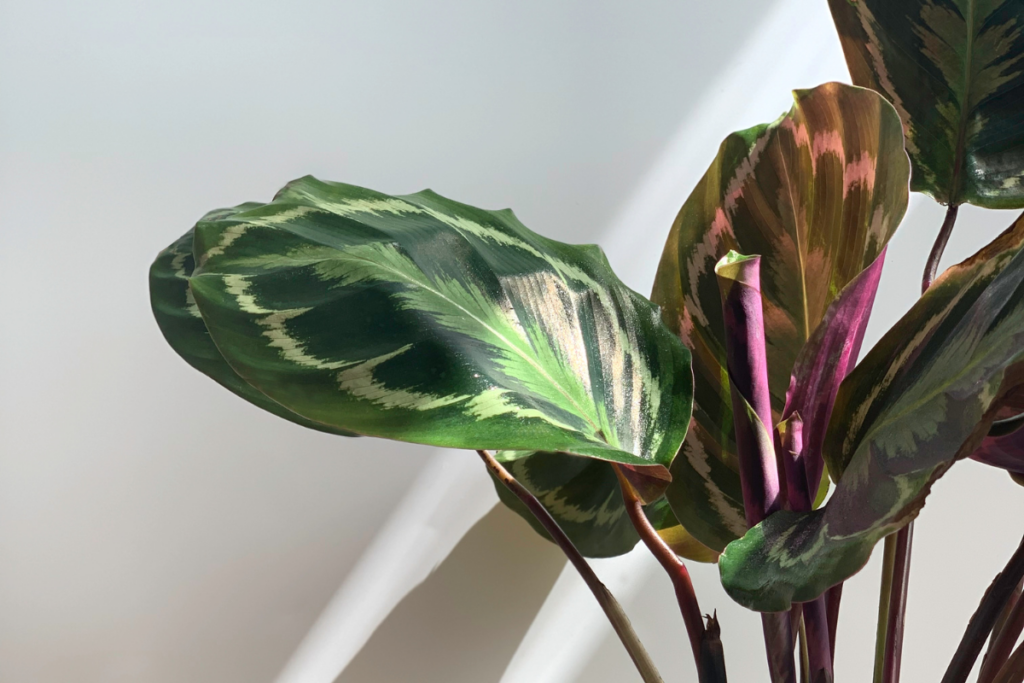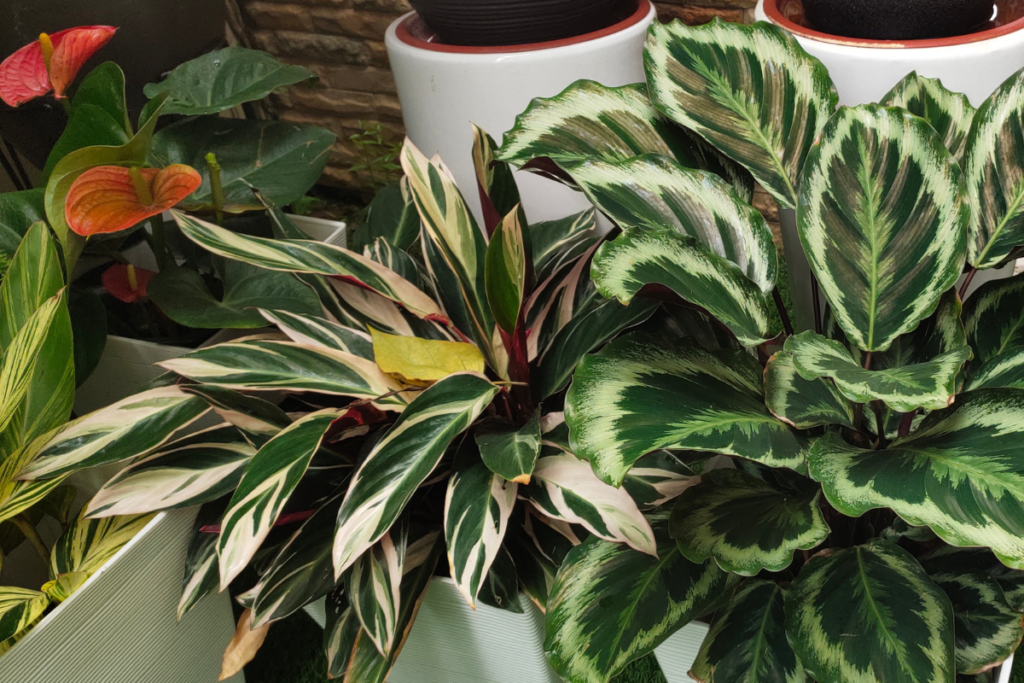Calatheas are well-known for their strikingly patterned foliage and are popular among houseplant enthusiasts. One variety, the Calathea Medallion, is a striking Calathea plant with a one-of-a-kind appearance that is ideal for low-maintenance indoor gardening. They have a quick growth rate and are simple to reproduce, adding brightness to your indoor plants. Read on for our calathea medallion care guide.

Because of their huge, “medallion”-like foliage with a dazzling green design on top and a deep burgundy below, they are quite popular among plant enthusiasts. But how do you take care of this unusual plant?
The soil must be mildly damp yet well-draining for Calathea Medallion plants. Water sparingly just when the top layer starts to dry out. Keep the plant in a well-lit area that is distant from the sun. Only fertilize during the growth season, and limit water during the dormant season.
Please continue reading to find out the best care for this plant since we have all the inside information you need to have a flourishing Calathea Medallion.
Profile

General Information
Calathea Medallion (Calathea veitchiana “Medallion” or Goeppertia veitchiana), also known as “Prayer Plant,” is one of the species of perennial tropical plant that comes from the family Marantaceae, the Prayer Plant family.
They are native to Ecuador and Peru, and other tropical nations. These Medallions may be cultivated as a houseplant or terrarium plants.
Calathea Medallions possess beautiful foliage that is typically more elaborate, with stripes, flecks, and vein lines in hues such as dark green, light green, and occasionally maroon, purple, or red.
Furthermore, it’s fun to watch Calathea medallion plant at night since certain types bend up slightly, showing the multicolored undersides of their beautiful leaves.
Etymology
The Calathea “Medallion” veitchiana is named after Cuenca, a plant found by Victorian plant enthusiast and collector Richard Pearce in 1862 and named for his employers, James Veitch & Sons. The name “Goepperti” derives from Johann Heinrich Robert Goeppert, a German botanist and paleontologist.
Because of their huge, “medallion”-like leaves, which have a dazzling green design on top and a deep burgundy below- are quite popular with plant enthusiasts.
Flowering
The Calathea Medallion rarely flowers indoors. These do often bloom in the wild, but when they do, it produces stunning tiny, insignificant flowers with a light green star shape that bloom in the summer but have no scent.
Season of interest and Purchasing
Calathea Medallion blooms best in the spring or summer, with some varieties blooming best in the fall. It may be cultivated to be used as a vase decoration for other flowers.
It also produces beautiful plants for gardens. This plant is ideal for those looking for low-maintenance gardening. Its fuzzy, appealing look helps both air quality and house décor.
This plant is available in plant nurseries, on Etsy, and on Amazon.
Growth
Calathea Medallion is a fast-growing tropical perennial that thrives and achieves its full height potential (up to 2 feet) in one year before halting to develop. The foliage is brilliant green, bushy, thin, and wavy when young. As the leaves mature, they become deeper green on top and maroon to burgundy on the underside.
Calathea Medallion Overview
| Scientific name | Geoppertia veitchiana ‘Medallion’ |
| Common name/s | Calathea Medallion, Medallion Calathea, Medallion Plant |
| Family | Marantaceae |
| Growth Habit | Herbaceous |
| Height and Spread | Can grow up to 24-36 inches tall, and a spread of 12-18 inches |
| Classification based on life cycle | Perennial |
| Origin and Distribution | Originates from Brazil, South America, and other tropical countries |
| Climate Zone | Generally warmer climate |
| USDA Plant Hardiness Zone | USDA Zone 9-12 |
| Color | Dark green leaves on top, maroon to burgundy at the bottom |
RELATED: 15 Breath-taking Types Of Calathea For Your Private Tropic Corner
Care Tips
Light Requirements
If you don’t supply the correct sort of light, the elegance of the Calathea Medallion’s variegated or patterned leaves might fade. Calathea Medallions thrive in medium, indirect light, so make sure to keep yours happy and healthy. It can also flourish in low-light conditions. They can thrive in both natural and artificial lighting.
Avoid direct sunlight, which can cause sunburn and leaf scorching. This plant grows best just a few feet away from a north-facing window, but it may live almost anywhere as long as it is not absolutely dark. This will produce a more vibrant color and longer foliage.
You must keep this plant out of direct sunlight to prevent the leaves from being harmed, being sunburned, and altering the color of the foliage.
Temperature Requirement
Maintaining the temperature of the Calathea Medallion is one of the more accessible aspects of its care. Calathea is a tropical plant; its ideal temperature range is 60 to 70 degrees Fahrenheit annually. The Calathea Medallion is susceptible to temperatures below 50°F (10°C), since it will be prone to damage in cold weather.
To minimize fungal concerns, do not place your plant in drafty areas. It is also recommended to maintain fresh-air ventilation.
Water Requirement
The Calathea Medallion requires moisture, especially during its active growing season in the spring and summer. They love moist soil but cannot endure soggy soil.
Moderate watering is recommended once a week or every two weeks. In the winter, you can reduce this watering to once a week, but always make sure the soil is dry before watering.
It is essential to keep the soil moist but not saturated. To test this, simply press your finger into the earth until your knuckle touches the soil. Allow the top two inches of potting mix to dry before watering again to ensure that it gets enough moisture to stay wet until the next watering.
Humidity Requirement
A lack of humidity is characterized by dry, crunchy leaf tips and edges. It is also possible for the leaves to become brown. You may achieve the 40%-60% humidity standard needed for Calathea Medallion by using a pebble tray, humidifier, or mist.
It contributes to a more humid environment, which is ideal for growing various types of houseplants and preserving the color of their leaves.
Soil Requirement
Calathea Medallions prefer well-drained soil to flourish. As with other calathea, give your prayer plant an organic, well-draining soil mixture to stimulate good blooming and to ensure the soil is nutrient-rich and organic. The ideal pH level is 6-7.
A loose potting mixture of cactus soil, orchid mix, vermiculite, and perlite is ideal for this. A superior soil mix should also have an appropriate drainage system, water retention, and aeration qualities.
Fertilizer Requirement
Calathea Medallions should be fertilized sparingly. Any general-purpose, foliage-preserving fertilizer usually used on houseplants will do. During the growing season, apply a liquid fertilizer (for houseplants) strong in nitrogen (3:2 NPK ratio) at half the strength of the recommended dosage they require to thrive rather than merely survive.
Fertilizer should be used once a month during the growth season, which lasts from spring until the end of summer. Fertilization should be reduced or halted throughout the winter.
Space Requirement
The Calathea Medallion plant prefers a certain shade, namely semi-shade to shadow. Set this plant in a north-facing window to obtain enough light. It may be grown in soil or in pots, although it prefers small spaces and visually appealing containers like terrariums. Furthermore, the prayer plant should be spaced from its neighbors by at least 18 to 24 inches.
Growing And Planting Tips

Propagation
The best way to propagate Calathea Medallion is by root division. When repotting a calathea in spring or summer, it is easiest to divide it.
Division is performed to propagate plants at the repotting stage. It is often performed at the start of the growing season. If your Calathea medallion has grown too large, trim it down and save the cuttings for additional plants!
Propagation By Root Division
When repotting your Calathea plant, dust off any excess soil before removing it from the pot at the roots and stems. You may use your hands to separate the stems from one another by grabbing the natural limit of each stem.
Although it might be essential to cut the roots, take care not to harm the main root balls. If necessary, use a clean, pointed tool to pry them apart with your fingertips.
Replant the mother plant in its original same pot with new soil, ensuring that the roots are submerged, and the plant is resting against the soil rather than directly on top of it. There must be multiple stems from which individual plants can be formed.
Repot the entire plant in pots that are roughly the same size as the one from which the calathea recently emerged. The plant may then be removed from its pot and soil, and the smaller plants separated. Then, in various pots, plant them all.
Pruning
When it comes to pruning the Calathea Medallion, it’s more about keeping it clean and removing dead or dying sections so that the energy from the roots may be channeled into developing and sustaining the plant’s healthy development.
Cutting the yellow or dry leaves will save the plant from wasting resources and energy on them at the expense of other, healthier parts of the plant. This will help your plant’s growth pace, and the dead leaves may be easily removed.
Potting And Repotting
The Calathea Medallion may be planted in ceramic, terracotta, or other types of pots. To avoid root rot, fill a planter or container with well-draining potting soil.
Repot your Calathea plant into a new pot with fresh potting soil every year or two to avoid problems like completely root-bound stunted growth or the soil losing part of its nutrients during a drought.
Calathea Medallion Care
| Light | Medium to indirect bright light |
| Temperature | Intermediate to warm, 60-70 degrees Fahrenheit |
| Water | Once a week, increased in summer, decreased in winter |
| Soil | Airy, light, well-draining mix |
| Fertilization | Regular household fertilizer, once a month |
| Space | Minimal space |
| Propagation | Via root division |
| Blooming | Rarely blooms, enough sunlight and maturity needed |
| Pruning | Regular pruning |
| Potting | Regular potting mix, use of perlite, vermiculite, peat moss, coco coir and sand is recommended |
Problems And Troubleshooting

Overwatering
In the event that you overwater your Calathea medallion plants, they will drown. An overwatered plant is likely to have yellow calathea medallion leaves.
The roots of your houseplant are dying about the time when the yellowing of the leaves appears. The results of overwatering include yellowing foliage and stunted, sluggish growth.
In addition to root rot, damp soil, and even death, plants can also suffer from leaf burn or scorch. Consider altering the container and soil to provide more drainage and faster soil drainage to decrease the consequences of overwatering.
Underwatering
Plants that don’t get enough water or have excessively dry air may get dry leaf tips and edges. The leaves change shape and coil into exquisite spirals as the liquid in them dries out. Because of its developing environment, a plant that receives little water will have dry leaves, brown tips, leaf drops, withering, and curled leaves.
If the plant is drooping and the leaves are also dry and wrinkled, you should water it more often. Maintaining the plant’s watering routine, being mindful not to let the soil become too wet, and providing it with adequate bright, indirect light can assure its sustainability. Make sure to thoroughly water it, all the way to the roots.
RELATED: Calathea Rufibarba: The #1 Care, Propagation, and Watering Guide For This Fuzzy Plant
Nutrient Deficiency
Deficiencies can happen when plants are unable to absorb nutrients from the soil due to poor growing circumstances. Yellowing of the leaves, interveinal yellowing, diminished internodes, or an abnormal hue of the foliage, such as red, purple, or bronze, are signs of nutrient deficiency.
A good maintenance routine is also necessary to keep a plant from experiencing nutritional deficits. As calcium supplies for crops, use lime, gypsum, calcium nitrate, or crushed eggshells. Plants with nutritional deficiencies can temporarily be treated with a spray of epsom salts on their leaves.
Flowering Problems
It is incredibly rare to see a medallion plant flower on a Calathea medallion that has been potted up indoors, no matter how hard you try. These bloom on a regular basis outdoors. Only until the plant is fully mature, which might take a few years, will it bloom.
The majority of Calathea medallion flowering occurs on plants that are grown outside throughout the year in tropical environments like the rainforest.
Brown Edges Or Curly Leaf Tips
Browning or curling of your plant’s leaves is an indicator of too much sunlight. Another possible reason is chlorine or other salts found in tap water.
To address this issue, use filtered water or any of the water mentioned in the water requirements above. You may also relocate your plant to a shadier place if suspecting that this is due to intense sunlight. Moreover, you should trip the brown or damaged leaves so that your plant grows lush green leaves.
Diseases
Any plant can be susceptible to diseases if not properly taken care of. Common diseases of the Calathea plants include leaf spots and root rot.
Leaf spots can be spotted if you notice water-soaked spots on the surface of your plant’s leaves. This disease can severely damage your plant’s foliage and may even kill it if not treated. On the other hand, root rot can usually be noticed through a foul odor.
These diseases are both results of overwatering, so make sure to get well-draining soil and only water your plant as necessary.
Pests
Mealybugs and spider mites are the most common enemies of the plants in the Marantaceae family. Usually, they are more susceptible to these common pests when they are overwatered or underwatered. They feed on the plant tissues and sap, thereby depriving the plant of necessary nutrients leading to slowed growth.
Spider mites multiply quickly, so if you see the presence of webbings between stems and leaves, best to address them immediately.
You can use neem oil, a natural pesticide, to get rid of them. Mix 2 teaspoons of neem oil and one teaspoon of liquid dish soap with a quart/liter of lukewarm water. Place in a spray bottle and spray over the peperomia leaves.
You may also use 70 percent isopropyl alcohol and apply them directly to the bugs to kill the plant pests.
Calathea Medallion Pests and Diseases
| Common Pests/Diseases | Symptoms | Treatment and Prevention |
Common diseases include crown rot, stem rot, root rot, leaf spot, fungal diseases, and Xanthomonas infection | Yellowish rimming around black or dark brown spots on leaves | Avoid overwatering. Keep soil dry. Avoid too high humidity. Proper ventilation is needed around the plant. Remove infected parts of fungal infections to avoid spreading. |
| Common pests include mealybugs, spider mites, aphids, and scales | Visible insects on the surface | Spray plant with warm, soapy water. If infestation is present, use insecticide or neem oil. Use diatomaceous earth. |
Problems With People And Animals
Toxicity
All calatheas are non-toxic to humans and pets, including the Calathea Medallion. Since it is non-toxic, it is an excellent houseplant if you do not want the hazards connected with plants such as philodendrons. However, chewing any houseplant is not advised.
However, although you don’t know what chemicals or pathogens are in the soil or fertilizers you use, it’s never a good idea to let your dogs and children have unrestricted access to your plants. So it’s better to keep houseplants away from pets and children.
Calathea Medallion Meaning And Symbolism
The term “Calathea” is derived from the Greek word “kalathos,” which means basket or vessel, as it was formerly believed that Native South Americans utilized a section of the plant to construct baskets. The flowering plant genus “Calathea” is also a member of the Marantaceae family.
These Calathea plants, commonly known as prayer plants, get their name from the distinctive leaf motion, or nyctinasty. When they “nap” at night, they fold their leaves upward (like praying hands), then unfold them again in the morning.
Due to its spherical leaves, which represent good fortune, this plant is also known as the money tree in feng shui (which can come in the form of money, health, or fame).
Calatheas also represent a fresh start. The phrase “to turn over a fresh leaf,” which is what the plant does when it becomes dark, is where that meaning originates. Because of this symbolism, it is best to give this plant to someone who is starting over in life and having a fresh, new start.
| General Meaning | Fresh start, good fortune |
| Symbolism | New beginnings, turning over a fresh start |
RELATED: Calathea White Star: The #1 Care, Propagation, and Watering Guide
Landscaping And Gardening Ideas

Companion Plants
The three plants, Hoya, Neon Pothos, and Prayer Plant, may create amazing plant combinations.
Calatheas come in an astonishing variety of color combinations, from green tones to burgundy and silver tones. When you include these companion plants in your collection of indoor plants, you will dazzle everyone who sees it.
All three of the green foliage plants look fantastic combined in this rustic planter. The eye-catching hue of these pothos, hoyas, and calatheas will surely attract observers. This lovely indoor plant has large leaves with striking dark green patterns. This is the one for you if you like big, gorgeous plants.
Landscaping Ideas
Calathea is a houseplant that really purifies the air, adding beauty to any décor while also improving the quality of the interior environment. It gives our homes and gardens more life with its enhanced ornamental impact and unusual leaves.
You may also group the Calatheas friends together to make a nice, refined green retreat. It’s great for a variety of containers and looks great in a hanging basket or on a small table.
| What to plant with | Pothos, Hoyas, Bird of Paradise, Areca Palms, Fire Spike, Heliconia, Variegated Arboricola, Croton, Chenille Plant, Pentas, other Tropical Plants |
| What NOT to plant with | Basically nothing |
Frequently Asked Questions
Why does the appearance of my Calathea medallion change from morning to night?
Due to the way the Calathea medallion’s leaves fold at night and then unfold in the morning, it is frequently mistaken for a prayer plant.
Is a sunny window the best place for my Calathea medallion?
No, you should place your Calathea medallion in indirect sunlight in a bright area. The leaves might be burned by too much sun.
How do you propagate Calathea Medallion?
Calathea Rufibarba is propagated using root division. Just divide the plants by separating them via their roots. Then, put them in a proper growing medium and allow the roots to develop extensively.
Should I mist my Calathea?
It depends on your environmental conditions. For example, if your place is too dry and humid, you may help maintain the optimum humidity level by misting frequently. However, if your place is already at the optimum, skip misting because extreme moisture can make your plant rot.
How big do Calathea plants get?
Calathea plants can grow more than 2 feet tall. Some species may even grow up to 10 to 12 feet tall with proper nourishment and care.
Final Thoughts
This attractive perennial plant comes from the tropics. The enormous, ornately patterned leaves of these Calathea medallion plants are appreciated for their ability to enliven any indoor environment.
Consequently, it’s an excellent option for low-maintenance indoor gardening. The Calathea Medallion may be taken care of easily. It needs a thorough inspection and an effective growth maintenance schedule.
Pets are welcome around most Calathea kinds! Since it is non-toxic and suitable for both people and animals, this plant is well-liked by lovers of indoor plants. You’ll be mesmerized by adding a Calathea medallion plant to your collection.
Editor’s Recommendations
Golden Pothos Vs. Hawaiian Pothos: Top Similarities and Differences You Must Know
Philodendron Dark Lord: The Best Care, Propagation, and Watering Guide
Sansevieria Cylindrica: The Best Care, Watering, and Propagation Guide







